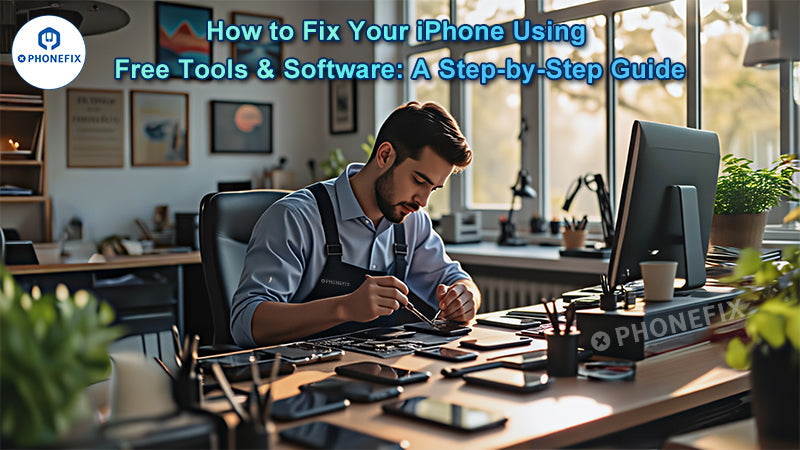In today's smartphone market, the iPhone has gained widespread popularity due to its outstanding design, powerful performance, and excellent user experience. However, after some time of use, iPhones can easily encounter software issues, screen freezes, or battery health problems, often requiring paid repairs. Fortunately, there are several free tools available that can help us resolve most common issues. In this guide, China Phonefix will walk you through the steps to use free software and tools to fix common iPhone problems,enabling you to easily maintain the proper functioning of your device.
Before diving into repairs, it's crucial to understand the common issues iPhone users face. Some of these include:
Software Glitches:
Software glitches can be incredibly frustrating. Apps may crash unexpectedly, or the system may freeze, leaving you unable to perform basic functions. Sometimes, your iPhone might even shut down without warning, disrupting your day. Understanding these issues helps in identifying whether they stem from specific apps or the iOS system itself.
Battery Problems:
Battery issues are among the most common complaints from iPhone users. You may notice your battery draining rapidly even when you're not using your phone heavily. Alternatively, your device might not charge properly, which could be due to a faulty cable, a malfunctioning charging port, or battery degradation. Recognizing these signs early can help in maintaining iPhone battery health.

Screen Issues:
Screen problems can manifest as unresponsive touchscreens or display abnormalities. Your iPhone screen might not register touch inputs correctly, or you might see flickering lines and other display issues. Such problems can be caused by software bugs, physical damage, or hardware malfunctions. Proper diagnosis is essential to determine the right repair approach.
Free iPhone Repair Software:
Several software solutions can help you diagnose and fix iPhone problems. Here are some of the most popular free options:
1. iTunes: Besides being a media player, iTunes can restore your iPhone to factory settings, which can resolve many software-related issues. Ensure you have the latest version installed. Regular updates provide new features and bug fixes that can improve the repair process.
2. Dr.Fone - Repair (iOS): This tool offers a free trial that allows you to fix various iOS issues like system crashes and black screens. It's user-friendly and provides step-by-step guidance, making it suitable for users with limited technical experience.
3. ReiBoot: A free tool that helps you enter and exit recovery mode without data loss, making it ideal for fixing boot loop issues. It simplifies complex recovery processes, allowing you to resolve boot issues quickly and efficiently.
Free iPhone Repair Tools & Guides:
In addition to software, having a physical Phone repair kit can be beneficial for hardware-related issues. Some components of a free iPhone repair kit include:
Screwdriver Tools: To open the iPhone casing. Precision screwdrivers are essential for dealing with the tiny screws found in iPhones, ensuring you don't strip or damage them during repairs.
Plastic Spudgers Tools: For prying open the phone without damaging it. These tools are crucial for separating delicate components without scratching or breaking them.
Precision Tweezers: For handling small components. They allow for precise manipulation of tiny parts, which is often necessary when dealing with intricate internal components.While some tools might not be free, you can often find basic repair kits at low costs.
Step-by-Step Guide to Repairing Your iPhone:
Before you begin your iPhone repair, make sure you have the basic phone repair tools ready, let's go through a step-by-step process to repair your iPhone.
Step 1: Back Up Your Data:
Before attempting any repair, it's crucial to back up your iPhone data. You can use iCloud or iTunes to ensure your photos, contacts, and other important files are safe.
Step 2: Diagnose the Problem:
Use the repair software to diagnose the issue. if your iPhone won't turn on, try using ReiBoot to enter recovery mode. The software will guide you through the process and help identify the problem.
Step 3: Repair Software Issues:
If the issue is software-related, use iTunes or Dr.Fone to restore your iPhone. Connect your iPhone to your computer, launch the software, and follow the on-screen instructions to repair the system.
Step 4: Repair Hardware Problems:
For hardware issues, like a cracked screen or iPhone battery replacement, use your repair kit to open the iPhone carefully. Follow online tutorials or guides specific to your iPhone model to replace faulty components. Hardware repairs require precision and patience, as improper handling can cause further damage.
Step 5: Test Your iPhone:
After the repair, test your iPhone to ensure the issue is resolved. Check all functionalities, such as the touchscreen, camera, and connectivity, to confirm your device is fully working correctly.
Tips for Successful iPhone Repairs:
1. Seek Online Help: If you're unsure about a repair process, online forums and video tutorials can be invaluable resources. They offer insights and tips from experienced users who have faced similar issues.
2. Seek Professional Help: If the issue persists or hardware repairs, it might be best to consult a professional technician. Professional intervention can prevent further damage and ensure that complex issues are resolved effectively.
Conclusion: Repairing your iPhone with free tools is not only cost-effective but also a rewarding experience. However, remember that not all repairs can be done at home, and some issues may require professional assistance. If you're not confident in your ability to repair your iPhone, it's best to seek help from Phone Repair Services technician to avoid causing further damage. Welcome follow Phonefix stores. We provide a wide variety of related Phone Repair Parts/Tools, and free share mobile phone Repair Guide.












